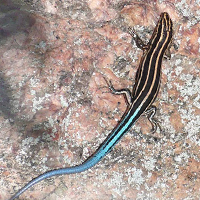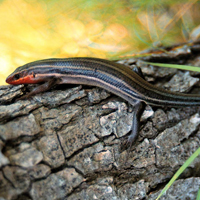Common Five-lined Skink
Scientific name: Plestiodon fasciatus



Photo credits: Wasyl Bakowsky (left), Ken Cornelisse (middle), Rob Tervo (right)
Status
Endangered (Carolinian population)
“Endangered” means the species lives in the wild in Ontario but is facing imminent extinction or extirpation.
Special Concern (Southern Shield population)
“Special Concern” means the species lives in the wild in Ontario, is not endangered or threatened, but may become threatened or endangered due to a combination of biological characteristics and identified threats.
Date added to the Species at Risk in Ontario List
September 10, 2009
Read the assessment report for the Carolinian population (PDF).
Read the assessment report for the Southern Shield population (PDF).
What it looks like
Common Five-lined Skink is a small (up to 8.6 cm) black or grey coloured lizard.
Juveniles have five cream-coloured stripes along their back and a blue tail. The stripes and blue tail fade with age.
During the breeding season, males have orange colouration around the jaws and chin. Common Five-lined Skink feeds on insects, worms and other invertebrates. They are very agile hunters.
Where it lives
Common Five-lined Skink enjoys basking on sunny rocks and logs to maintain a preferred body temperature between 28 and 36°C. During the winter, they hibernate in crevices among rocks or buried in the soil.
In North America, Common Five-lined Skink occurs throughout hardwood forests from the Atlantic seaboard to Texas and Minnesota, and from southern Ontario to the Gulf of Mexico.
In Canada, the species is limited to two distinct areas: one is along the southern margin of the Canadian Shield, and the other is in the Carolinian Zone in southwestern Ontario.
Where it’s been found in Ontario
There are two populations of Common Five-lined Skink in Ontario, occupying different types of habitat.
The Southern Shield population can be found underneath rocks on open bedrock in forests. The Carolinian population can be found under woody debris in clearings with sand dunes, open forested areas, and wetlands.
The Southern Shield population of Common Five-lined Skink is found on the southern margin of the Canadian Shield, from Georgian Bay to Leeds and Grenville counties. The Carolinian population is comprised of several distinct subpopulations distributed near the shores of:
- Lake Erie
- Lake St. Clair
- Lake Huron
What threatens it
The largest threat to both populations of Common Five-lined Skink in Canada is from habitat fragmentation, or the breaking up of larger, continuous habitat into smaller patches of habitat. In the past, habitat fragmentation was increasing due to physical barriers and long-term climate change but is now also increasing due to human actions.
The Common Five-lined Skink faces many threats to its habitat from urban sprawl and commercial development, especially in southwestern Ontario. In the Carolinian population, transportation and service corridors have caused increased mortality and also barriers to skink movement.
The Canadian Shield population is also threatened by residential and commercial development as well as transportation and service corridors, although the risks are lower than for the Carolinian population.
Other threats to both populations of Common Five-lined Skink are:
- invasive and other problematic species, such as the Raccoon, that prey on Common Five-lined Skink
- disturbances from human visitation, leading to trampling and loss of microhabitat
- natural system modification, such as forest encroachment on prairie and savannah habitat
Action we are taking
As an endangered species, the Common Five-lined Skink (Carolinian population) and its habitat are protected under Ontario’s Endangered Species Act, 2007 (ESA). The ESA also requires the preparation of recovery guidance for endangered species to guide recovery efforts for the species in Ontario.
While special concern species such as the Common Five-lined Skink (Southern Shield population) do not receive species or habitat protection under the ESA, the act requires us to prepare recovery guidance for special concern species unless a recovery strategy or management plan is required for the species under the federal Species at Risk Act.
All species listed on the Species at Risk in Ontario List may be eligible for consideration for government funding through the Species at Risk Stewardship Program.
Recovery strategy
Recovery strategies that are developed for more than one population of a species, such as Common Five-lined Skink, meet the requirements for a management plan for those populations that are classified as special concern.
Read the executive summary (September 10, 2010)
Read the recovery strategy (September 10, 2010)
Government response statement
A government response statement outlines the actions the government intends to take or support to help recover the species.
Read the government response statement (June 15, 2011)
Five-Year Review of Progress
A five-year review reports on progress made toward protecting and recovering a species, within five years of publishing a species’ government response statement.
Read the report on progress towards the protection and recovery of 27 species at risk, including Common Five-lined Skink (2016).
Habitat protection
A habitat regulation defines a species' habitat and may describe features (such as a creek, cliff, or beach), geographic boundaries or other unique characteristics.
Read the habitat regulation for Common Five-lined Skink (Carolinian population) (July 1, 2012)
What you can do
Report a sighting
Submit your observations of species at risk to the Natural Heritage Information Centre (NHIC) , which is Ontario’s conservation data centre. Join the centre’s Rare Species of Ontario project in iNaturalist, an online plant and animal identification app, to quickly and easily submit your observations.
Volunteer
Volunteer with your local nature club or provincial park to participate in surveys or stewardship work focused on species at risk.
Be a good steward
- Private landowners have a very important role to play in species recovery. If you find species at risk on your land, you may be eligible for stewardship programs that support the protection and recovery of species at risk and their habitats, such as the Species at Risk Stewardship Program.
- Never buy Common Five-lined Skinks that have been caught in the wild and never buy a native species of any kind that’s being sold as a pet.
- The Carolinian Zone of southern Ontario supports an impressive diversity of plants and wildlife, including many species at risk. Carolinian Canada Coalition is working to protect and restore the natural heritage in this important area.
- Visit the Herpetofaunal Atlas website to learn more about Ontario’s reptiles and amphibians and the data collected on them. Visit the Ontario Nature website to see how you can participate and learn more about Ontario’s reptiles and amphibians.
Report illegal activity
Report any illegal activity related to plants and wildlife to
Quick facts
- When attacked by a potential predator, a skink’s tail can “autotomize”, or spontaneously break off and thrash for several minutes, distracting the predator so the lizard can escape. The tail is able to grow back at a rate of about 6 millimetres a week.
- The scales of the Common Five-lined Skink are un-ridged, giving it a smooth, shiny appearance.